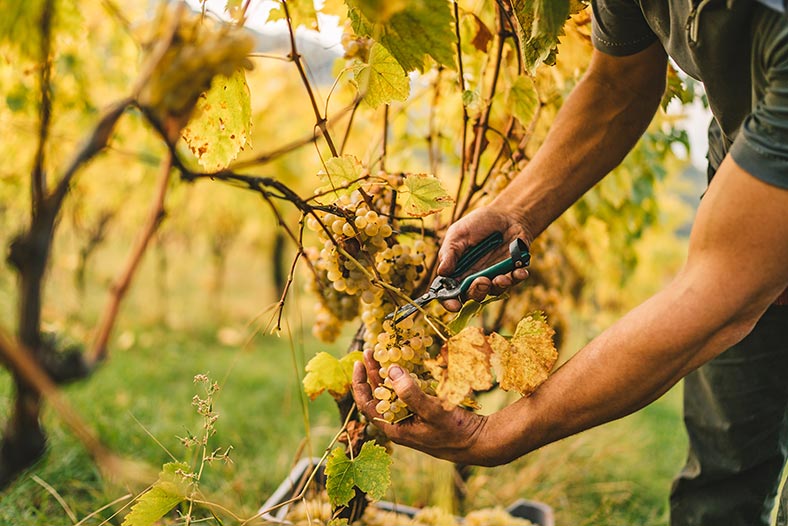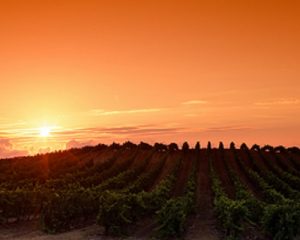
The passion held by wine lovers and their thirst for the next big thing means that some are already intrigued by the results of the 2020 harvest. We’ve heard the first indications of how things are going in the vineyards, and we’ve put them together here.
Before even having brought the first bunch of grapes into the winery, producers in France (and all over the world!) had already lived through quite an unusual 2020. Not because their work in the vineyard or the cellar was particularly impacted by Covid-19 (the day-to-day running of domains could continue in the usual way), but rather because the global health crisis has had a catastrophic effect on sales. Certain shops and online retailers have managed to carry on business as (almost) usual, but this is far from the case for the hospitality industry, with bars and restaurants taking a huge hit. These are the kinds of places where top quality wine is sold and enjoyed, thus the effects of lockdowns around the world have been huge for fine wine. We don’t yet know the full effect this has had, or will have, on French producers, but it is clear that dents in their business activity will be significant. This is especially the case for Champagne producers, who have suffered from the almost total halt of parties, weddings, and other festive events and celebrations.
All this is to say that, whilst the quality of the 2020 harvest has been scrutinised as normal, we can’t ignore that this has been somewhat eclipsed by the events of this year so far.
General impressions
One thing is sure: yet again, the different winemaking regions of France have had quite a particular year, a phenomenon we’ve seen increasingly often over the past decade or so. We’re also hearing more experts referring to a “climate imbalance” rather than a ‘simple’ warming, the latter likely being just one facet of the crisis. So, we can include very late frost, frequent hale storms, a spreading drought, and sudden heatwaves that roast the vines in this growing list of recurring problems. We’re moving further away from our understanding of a ‘normal’ year, with a cold winter to cleanse the soil, a rainy spring to fill the water groundwater table, a warm but not excessively hot summer, followed by some refreshing showers just before the harvest. Recently, it’s almost as though the year has just two seasons: six months of autumn from October to March, and six months of summer from April to September.
Generally speaking, the very warm spring we had this year led to an earlier plant cycle in vineyards across France, with many areas later having very early harvests, with some even beating records, especially in the ‘grand est’ region of eastern France. Summer dryness blocked ripening in some cases due to water stress. In the end, many vineyards didn’t harvest any earlier than in 2003 for example. Having said that, as one Burgundy producer underline, “we don’t want to go back to rainy, October harvests!”
Another phenomenon across the Hexagon this year has been widespread drought, and this adding to the general dryness that has already persisted for several years, notably in the south and south-east. The impact of this was intensified this year by sudden heat waves that in some cases literally ‘fried’ vine rows at the edge of certain parcels (those at the centre being better protected by foliage). Even in places where conditions weren’t as extreme as this, the general dryness did reduce yields by quite a lot, with the grapes containing less juice. This won’t be without effect on the resulting wine, particularly red wines, since the proportion of skin to juice will be altered in the vinification vats. Having said this, the vast majority of the grapes were in good health at the point of harvest.
Region by region
In Burgundy, there were record-beating early harvests, with the grapes intended for crémant cuvées brought in for the 12th August! The harvests were also two weeks early on the Côte Chalonnaise for example, based on the average of the past 25 years. Like everywhere, yields are slightly lower than usual, except in clay-rich areas that retain water better. General opinion is that the whites have come out well, better than in 2003 for example, with more acidity. The reds will be quite coloured and tannic, without having to undergo excessive extractions. Certain vineyards were baked in the sun, causing them to lose up to 15% of the harvest.
The more positive side is that the fruit was able to undergo a complete maturation cycle, which should allow to produce quality, rich, and concentrated wines. Some of these might resemble the 2003 vintage, but with a better ageing potential due to higher levels of acidity in the 2020 harvest. People have also mentioned a likeness to 2015 for the reds and 2017 for the whites.
The Bordeaux region seems to sit within the national average when it comes to this year’s weather conditions. The harvests were early, of course, though not as early as in 2003; not far from what we saw in 2011 and 2017. First impressions would suggest that the Cabernet Sauvignon and Cabernet Franc grapes have performed better than the Merlot which, in especially hot years, tends to become quite heavy and saturated. For the same reasons, Bordeaux’s white varietals are likely to lack the nice acidity seen in the 2018 and 2019 vintages. Finally, this year’s conditions don’t seem to be the best for sweet wines; the grapes will probably dry nicely on the vines (passerillage) but perhaps develop little noble rot.
In the southern viticultural regions (Languedoc, Roussillon, southern Rhône), the vines are rather more used to the heat, so they resisted well to 2020’s somewhat extreme conditions. The harvests were slightly quicker than usual, and different varietals had to picked in a much shorter space of time to seize the right maturity. Paradoxically, the nights were often quite fresh, making up for the heat of the day and allowing the vines to “breath”. Overall, the southern appellations are quite optimistic about the quality of their 2020 vintage, in both red and white, with wines a little less powerful and with a bit less alcohol than in 2019.
From the other regions, it has been noted that Champagne has seen a wonderful vintage across its zones and appellations. The Loire valley, as is often the case for northern regions, is delighted with a warmer year that should bring a good level of maturity to its Cabernet franc vines, as long as they haven’t fallen victim to water stress. As for the whites, we might have to look out for an eventual deficit in acidity. It’s still a bit early to say for the sweet and dessert wines. Finally, in the Jura and Savoie regions, this has been a good year with very healthy, ripe grapes; these vines naturally benefit from fresher nights since the vines are all grown at a certain altitude.
Of course, it will be a little while before we can finally taste the fruits of this year’s labour, but whatever happens, we cannot doubt that the year 2020 won’t be forgotten any time soon.



